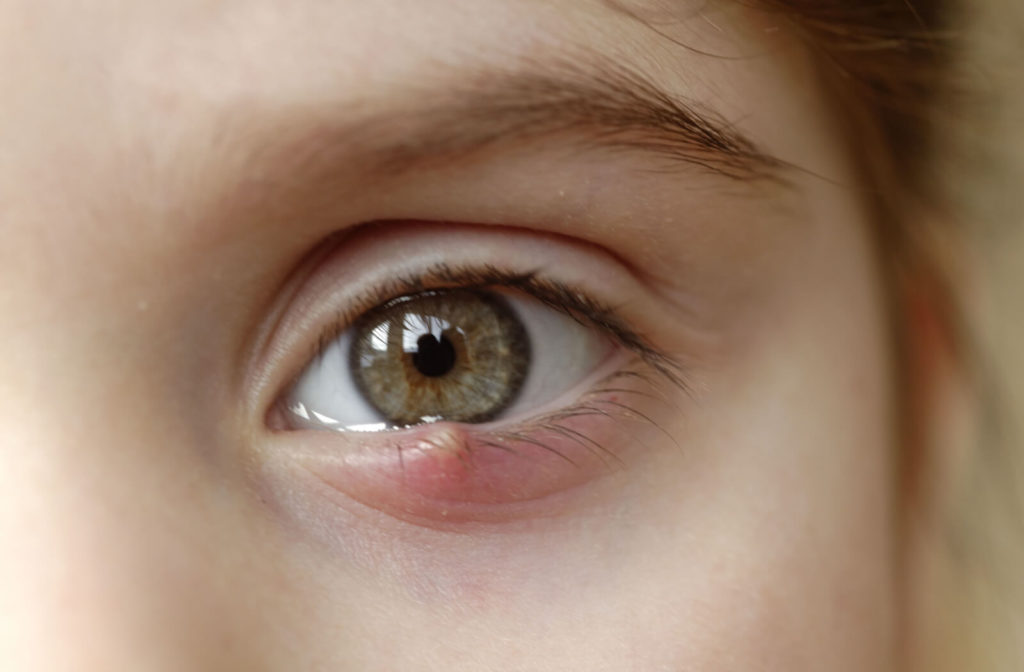Have you ever woken up with a painful bump on your eyelid, or have you ever noticed redness, itching, or discharge in your eyes? These are common symptoms of 2 eye conditions that are often confused: pink eye and styes.
While both can cause irritation and discomfort, they are distinct conditions with distinct causes and symptoms.
Pink eye, also known as conjunctivitis, is an inflammation of the conjunctiva, the clear membrane that lines the white part of the eye and the inside of the eyelids.
A stye, on the other hand, is a small, painful bump on the eyelid, usually near the base of the eyelashes.
If you’re unsure what you’re experiencing, your Optometrist is best person to call. Through a virtual visit or an in-person exam, t your Optometrist at Aurora 2020 can make the diagnosis and if necessary prescribe to appropriate medication to resolve the issue
What Is Pink Eye?
Pink eye is an inflammation of the conjunctiva, a thin layer of tissue that lines the inside of the eyelid and covers the white part of the eye. There are 3 main types of pink eye:
- Viral
- Bacterial
- Allergic
Viral Pink Eye
The virus that causes viral pink eye can be the same virus that causes the common cold. It’s extremely contagious and spreads easily through contact with an infected person’s hands, face, or personal items.
Viral pink eye usually starts in one eye and then spreads to the other eye. It can be accompanied by cold symptoms, such as a runny nose or sore throat.
Bacterial Pink Eye
Bacterial pink eye is caused by bacteria, most commonly Streptococcus pneumoniae and Haemophilus influenzae. It’s also extremely contagious, also spreading through contact with an infected person’s hands, face, or personal items.
Bacterial pink eye typically begins in one eye and spreads to the other. It may be accompanied by yellow or green eye discharge.
Allergic Pink Eye
Allergic pink eye is caused by an allergic reaction to substances such as pollen, dust, or pet dander. It’s not contagious and is usually seasonal or triggered by an allergen.
Allergic pink eye can affect one or both eyes and is frequently accompanied by other allergy symptoms such as sneezing, runny nose, or itchy skin.
Symptoms of Pink Eye
Pink eye symptoms can vary from person to person, but here are some common ones to watch out for:
- Redness in the white of the eye or inner eyelid
- Itchiness or irritation in the eye
- Watery or sticky discharge from the eye
- Swelling of the eyelids
- Blurred vision
- Sensitivity to light
- Feeling like there’s something in your eye

What Is a Stye?
A stye, also known as a hordeolum, is a red, painful lump that forms inside the eyelid. It’s caused by a bacterial infection of the oil glands in the eyelid.
Styes can format the base of an eyelash, or deeperinside the eyelid.
Styes can be brought on by:
- Makeup or cosmetic use: Sharing makeup or using expired makeup can increase the risk of infection.
- Rubbing or touching the eyes with dirty hands: This can transfer bacteria from the hands to the eyes.
- Stress or fatigue: Stress or fatigue can weaken the immune system and make it easier for bacteria to cause an infection.
Symptoms of a Stye
Symptoms of a stye may include:
- A small, red bump on the edge of the eyelid
- Swelling of the eyelid
- Pain or discomfort in the eye
- Tenderness when touching the affected area
- Crusting or discharge from the affected area
- Blurred vision (if the stye is large enough to press against the eye)
Differences Between Pink Eye & Styes
Pink eye and styes are two different eye conditions that can be easily confused. Here are some of the key differences:
- A stye affects the eyelid, whereas pink eye affects the conjunctiva.
- A viral or bacterial infection or an allergic reaction causes pink eye, whereas a bacterial infection of the oil glands in the eyelid causes stye.
- Pink eye is highly contagious, whereas a stye is not.
Pink Eye Treatment
The treatment for pink eye depends on the cause.
- If it’s caused by a bacterial infection, antibiotics may be prescribed. Antibiotic eye drops or ointment can help clear the infection and reduce symptoms. The infection usually clears up within a week.
- If it’s caused by a viral infection, antibiotics likely won’t work. The infection usually clears up on its own within a week or two.
- If allergies are to blame, antihistamines or decongestants can help alleviate symptoms.
To reduce discomfort, cool compresses or over-the-counter eye drops may be used for any type of pink eye. Avoid wearing contact lenses until the infection clears up.
Stye Treatment
The majority of Styes can be treated at home with self-care measures such as:
- Applying warm compresses to the affected area for 10—15 minutes at a time several times per day. This can aid in the opening of the blocked oil gland and promote healing.
- Hand washing is essential, especially before touching your eyes.
- Squeezing or popping the stye can spread the infection and cause more harm than good.
Ask Your Optometrist for Help
If you’re experiencing the symptoms of pink eye or a stye, don’t hesitate to book an appointment with the Aurora 2020 team.
We’re here to help you properly diagnose and prescribe for any eye concerns and give you the information you need to feel confident in the health of your eyes and vision.



